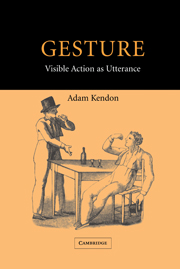Book contents
- Frontmatter
- Contents
- Acknowledgments
- 1 The domain of gesture
- 2 Visible action as gesture
- 3 Western interest in gesture from Classical Antiquity to the eighteenth century
- 4 Four contributions from the nineteenth century: Andrea de Jorio, Edward Tylor, Garrick Mallery and Wilhelm Wundt
- 5 Gesture studies in the twentieth century: recession and return
- 6 Classifying gestures
- 7 Gesture units, gesture phrases and speech
- 8 Deployments of gesture in the utterance
- 9 Gesture and speech in semantic interaction
- 10 Gesture and referential meaning
- 11 On pointing
- 12 Gestures of ‘precision grip’: topic, comment and question markers
- 13 Two gesture families of the open hand
- 14 Gesture without speech: the emergence of kinesic codes
- 15 ‘Gesture’ and ‘sign’ on common ground
- 16 Gesture, culture and the communication economy
- 17 The status of gesture
- Appendix I Transcription conventions
- Appendix II The recordings
- References
- Index
11 - On pointing
Published online by Cambridge University Press: 05 February 2015
- Frontmatter
- Contents
- Acknowledgments
- 1 The domain of gesture
- 2 Visible action as gesture
- 3 Western interest in gesture from Classical Antiquity to the eighteenth century
- 4 Four contributions from the nineteenth century: Andrea de Jorio, Edward Tylor, Garrick Mallery and Wilhelm Wundt
- 5 Gesture studies in the twentieth century: recession and return
- 6 Classifying gestures
- 7 Gesture units, gesture phrases and speech
- 8 Deployments of gesture in the utterance
- 9 Gesture and speech in semantic interaction
- 10 Gesture and referential meaning
- 11 On pointing
- 12 Gestures of ‘precision grip’: topic, comment and question markers
- 13 Two gesture families of the open hand
- 14 Gesture without speech: the emergence of kinesic codes
- 15 ‘Gesture’ and ‘sign’ on common ground
- 16 Gesture, culture and the communication economy
- 17 The status of gesture
- Appendix I Transcription conventions
- Appendix II The recordings
- References
- Index
Summary
In the course of his guided tour of Northant, GB takes his little group of tourists into the church. He describes the interior of the building and draws attention to various features. In one part of his discourse he says (GB 3.09.07) “there is Gil Crestwood (..…) and there is Floyd Craddock.” It would be impossible for any member of the group to know what he was referring to, however, without also taking into consideration the fact that, as he says this, he extends his straight arm upwards, angled first in one direction, then in another, in each case with his hand shaped so that only his index finger is extended. With these gestures, in each case, he directs his audience's attention to the location of the two objects he has named which are, in this case, statues. He points to each statue in turn, as he refers to them, but only by doing so does he make the speech in his utterance intelligible. Without these pointing gestures the meaning of GB's “there” in each case could never be known. As we saw in Chapter 6, gestures of pointing, or deictic gestures, have been recognized as a separate class by almost all of the students of gesture we have reviewed and it has always been understood that such gestures can play a fundamental role in establishing how an utterance is to be understood. There are very few studies, however, which have examined the way in which pointing is done.
- Type
- Chapter
- Information
- GestureVisible Action as Utterance, pp. 199 - 224Publisher: Cambridge University PressPrint publication year: 2004
- 2
- Cited by

